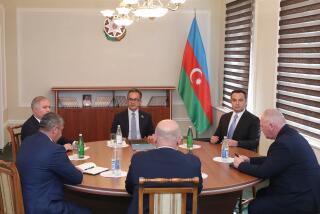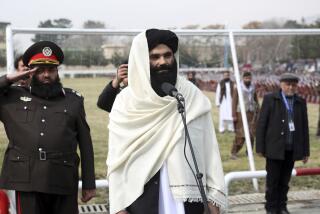Afghans Facing Prospect of Fighting on Their Own : Civil war: U.S. and Soviet arms that have fueled the 13-year conflict will be cut off at the end of the year.
- Share via
WAGHJAN GORGE, Afghanistan — Dug into the dusty ridgeline at Afghan Army Post No. 9, 1,000 feet above this strategic choke point 27 miles south of Kabul, stands the only semblance of control in this rugged, war-ravaged countryside. It is the first critical line of defense for the embattled regime of Afghan President Najibullah, whose forces now are faced for the first time with fighting a 13-year-old civil war on their own.
The only law in the Waghjan Gorge these days is the main gun barrel of a Soviet-built T-55 battle tank. Like the 43 others along the barren brown slopes overlooking the gorge, it is pointed directly at the villages below.
The tank guns have been largely silent threats for several weeks now, since the battle that demolished much of the valley. But they symbolize the precarious stalemate throughout Afghanistan as commanders on both sides of one of the bloodiest civil wars in modern history anxiously await the choice between a peaceful settlement and a fight to the finish.
“In that village there, we don’t fire on them anymore, and they don’t fire on us. We’ve signed a protocol with the village elders,” said Maj. Gen. Fateh Mohammed, Najibullah’s commander for Logar province, as he stood atop Post 9 and surveyed the bomb-cratered valley that runs through the heart of this strategic region.
“We blasted away at them with the tanks and rockets for some time. Eventually, the elders came to see me. About half the village is destroyed. But now, they’re loyal,” he said.
Indeed, for Fateh, like the officers of the Soviet occupation forces that came before him, the destruction of yet another village in a nation where two-thirds of the cities, towns and hamlets already lie abandoned and in ruins was more than worth it.
“This is a very, very important gorge. This is the only highway from Kabul to the south, to the city of Gardez, which is under siege by the rebels,” he said. “We must keep the road open and control it so the moujahedeen cannot use it to attack Kabul.”
And so the 3,500 government soldiers Fateh has stationed along this ridgeline, all of them in ragged and unmatched uniforms and tattered boots caked with mud and dust, are mostly idle now in their crude bunkers. They are on watch for the rockets that the Muslim fundamentalist rebels occasionally lob into their positions from the “loyal” villages down below.
“We’re just sitting here waiting,” Fateh said, “waiting and hoping for peace, but always prepared for the worst.”
This is the face of the seemingly endless Afghan war, which has left more than 1 million dead and 4 million more in refugee camps in neighboring Pakistan and Iran. Those who have stayed behind live in constant fear in a land where starvation, incarceration and destruction are among life’s few constants.
But now there is a new dimension to the war that in the beginning was largely East vs. West--communism vs. democracy--but has deteriorated in recent years into little more than Afghan tribal warfare. Now, the heavily armed factions in this intractable conflict, chief among them regime commanders such as Gen. Fateh and his tanks above the Waghjan Gorge, are alone for the first time in more than a decade.
On Friday, the ripples of radical reform in the Soviet Union, which fueled this war by sending the Red Army to invade its southern neighbor, finally reached Afghanistan.
The two major backers of the factions that have been tearing Afghanistan apart since 1979 will simply walk away at the end of this year, with Moscow and Washington cutting off military aid to Najibullah’s regime and the moujahedeen rebels.
For more than a decade, the conflict here has been a bitter Cold War confrontation fought through surrogates, with the United States sending billions of dollars in weapons and cash to the fractious Afghan guerrillas before, during and after the 1989 Soviet troop withdrawal, and the Soviet Union continuing to pour billions more in military hardware into Najibullah’s tattered but largely intact army after Moscow had brought home all its occupation forces, numbering more than 100,000.
In the first weeks after Soviet President Mikhail S. Gorbachev’s loyalists crushed the Soviet coup last month, the prospect of a U.S.-Soviet agreement to stop arms supplies actually emboldened many moujahedeen commanders here and in their bases in neighboring Pakistan.
The post-coup disarray in the Soviet Union had badly disrupted military and food supplies to the Afghan regime. Leaders of more than half a dozen major rebel groups met near the border to discuss an all-out offensive to take Kabul or, at the very least, seize Gardez, a major government-held city about 70 miles south of Kabul at the other end of the highway through Waghjan Gorge.
The Pakistani border city of Peshawar, the moujahedeen’s major political and military staging ground, was awash last week with rumors of a major rebel assault timed to coincide with a military coup by rebel sympathizers in the Afghan army in Kabul.
But such talk has all but collapsed in infighting and disagreement between moderate and fundamentalist rebel factions, who recently have spent nearly as much time killing off each others’ forces as they have fighting the Kabul regime.
Most military analysts in Kabul have concluded that last week’s announcement in Moscow of a U.S. and Soviet arms cutoff by the end of this year is likely to spark another bloody era of rebel infighting, as both sides in the conflict try to maintain a stalemate while struggling to negotiate a political solution for peace.
“It will certainly put Najib and his regime under pressure, but it will also put pressure on the opposition,” said an Asian military analyst in Kabul who has become an expert on the Afghan war. “Najib and his government have always performed better under pressure, whereas the opposition is liable to go into further disarray.
“This will likely push the moderates closer to the regime to reach a political, power-sharing solution, but the fundamentalists like Gulbuddin Hekmatyar will emerge much stronger, because he has access to money and his weapons reserves are better. He may not be strong enough to actually take Kabul, but he’ll be strong enough to torpedo any political solution.”
Indeed, in relying on an arms pipeline administered by conservative Muslim military leaders in Pakistan, the CIA funneled as much as 60% of the estimated $2 billion worth of arms and ammunition it provided the moujahedeen to the faction controlled by Hekmatyar, a bearded and turbaned crusader who is so anti-American that he once refused to accept a personal letter of thanks from former President Ronald Reagan soon after the Soviets began their troop withdrawal.
Aside from Hekmatyar, more U.S.-financed military hardware is now in the hands of other powerful fundamentalist rebel leaders, among them Abdul Rasul Sayyaf, whose principal backer is King Fahd of Saudi Arabia.
It is only in recent months that the U.S. arms have begun arriving in large quantities at the headquarters of the more moderate and better-disciplined moujahedeen commanders such as Ahmed Shah Masoud, a fierce and popular figure who controls a relatively cohesive region along the Soviet border through an administrative structure known as the Parliament of the North.
And the most moderate of rebel leaders, wealthy pro-American Afghan exiles such as Pir Gailani and Sighbatullah Mojaddidi, have gotten almost no American arms in recent years, making them little more than stateless politicians whose only power lies in their opposition to the rebel fundamentalists.
With so many competing and often cynical forces at work within the moujahedeen leadership, the years of bloody, regional stalemates like the one at Waghjan Gorge have bred a deepening sense of apathy--and, in some cases, anarchy--among rebel field commanders, who fought the original guerrilla “holy war” that drove out the Soviet army.
So dispirited are the rebels that some of those once-committed commanders have turned to Afghanistan’s lucrative heroin and opium trade, using their U.S.-supplied weapons to protect and export hundreds of millions of dollars worth of heroin now being sold on the streets of America and Europe.
One commander has busied his forces with the mining and smuggling of lapis lazuli, the semi-precious stone that is plentiful in the region he controls in Badakshan province.
Against that checkerboard of rebel disunity, Najibullah’s military appears to be a far more unified, though brutal, fighting force. Most independent analysts in Kabul estimate that Kabul’s military reserves are sufficient to fight “at medium levels of combat” for at least two more years without resupply.
“They can carry on basic operations for a long time to come,” the Asian analyst said.
Already, Najibullah has survived one bloody coup attempt from within the ranks of the harsh ruling party leadership that dominates the Afghan armed forces. His once-trusted former defense minister, Shahnawaz Tanai, joined with the chief of the air force in a two-day rebellion last year that just missed killing Najibullah when a rebel jet fighter dropped two bombs behind his office at the presidential palace.
But most of the independent analysts and diplomats in Kabul rule out another coup attempt, at least in the short run. The inner circle assembled by Najibullah, head of the KGB-created secret police before the Soviets handpicked him as leader in 1986, “are well aware they must hang together if they are not to hang for sure,” an East European diplomat said.
Even if the U.S.-Soviet arms cutoff becomes a catalyst for a political settlement, “another phase of the war will begin--revenge,” said the Asian military analyst, who has lived in Kabul for several years. “The most dominant traits in the Afghan culture are hospitality and revenge. And, with 1 million people having died in this war, you can only imagine the cycle of death that is to come.”
More to Read
Sign up for Essential California
The most important California stories and recommendations in your inbox every morning.
You may occasionally receive promotional content from the Los Angeles Times.













